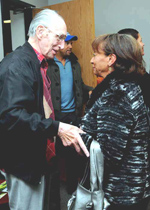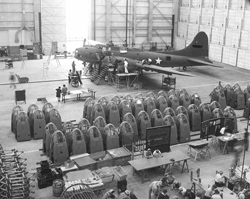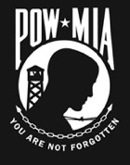 | |
|
An up close and personal interview with U.S. Air Force Veteran and Togetherweserved.com Member:
Capt Richard Fort Sheil U.S. Army Air Corps (1943-1945)
WHAT INFLUENCED YOUR DECISION TO JOIN THE MILITARY?
I was in my early 20s when the Japanese attacked Pearl Harbor on December 7, 1941. While I was shocked at hearing the news, I was not totally surprised. I always figured Nazi Germany would attack us one day but not the Japanese. Adolf Hitler had conquered most  of Central Europe by 1939 and spoke openly of destroying the United States. Japan, on the other hand, seemed only interested in grabbing up all the natural resources in the Pacific. I didn't think they had a beef with us. I guess I was wrong. of Central Europe by 1939 and spoke openly of destroying the United States. Japan, on the other hand, seemed only interested in grabbing up all the natural resources in the Pacific. I didn't think they had a beef with us. I guess I was wrong.
When Congress declared war on Japan and with Germany declaring war on us three days later, I felt a patriotic duty to sign up for military service. I knew I didn't want to join the Army or Marines because I could not imagine every taking a man's life face-to-face. I hoped to fight the enemy as a bomber pilot flying thousands of feet in the sky where I would never see the destruction and loss of lives I might have caused.
WHAT WAS YOUR SERVICE CAREER PATH?
I signed on as an Aviation Cadet, but had to wait for four months while being shifted from post to post before receiving an actual assignment to ground school at Santa Ana, California.
 Next was Primary at Thunderbird II in Scottsdale, Arizona, followed by Basic at Marana, finally Twin Engine at Stockton, California. Upon receiving my commission, I had my first training on the B-17 at Hobbs, New Mexico. I picked up a crew then at Salt Lake, Utah, moved to Rapid City, South Dakota for crew training. Just as we finished, I received orders to ship overseas to England. When tally time came, it was discovered there were six crews on the base, too many for Group size. A raffle was held and my crew lost, so we then went to Lincoln, Nebraska, picked up a new B-17 and received orders to fly to England, via Bangor Maine, to Labrador, to Iceland and finally to land in Scotland. There, we parted from our plane and went to a holding center and awaited orders on assignment. When orders came, we were to be part of the 94th Bomb Group located in AFB Rougham, just outside of Bury St. Edmonds. This airfield is one of the few wartime bases to retain its Control Tower into current times. Next was Primary at Thunderbird II in Scottsdale, Arizona, followed by Basic at Marana, finally Twin Engine at Stockton, California. Upon receiving my commission, I had my first training on the B-17 at Hobbs, New Mexico. I picked up a crew then at Salt Lake, Utah, moved to Rapid City, South Dakota for crew training. Just as we finished, I received orders to ship overseas to England. When tally time came, it was discovered there were six crews on the base, too many for Group size. A raffle was held and my crew lost, so we then went to Lincoln, Nebraska, picked up a new B-17 and received orders to fly to England, via Bangor Maine, to Labrador, to Iceland and finally to land in Scotland. There, we parted from our plane and went to a holding center and awaited orders on assignment. When orders came, we were to be part of the 94th Bomb Group located in AFB Rougham, just outside of Bury St. Edmonds. This airfield is one of the few wartime bases to retain its Control Tower into current times.
We had the usual indoctrination and practice flights and on May 29, 1944, we were assigned our first mission, followed shortly thereafter by two flights on D-Day, June 6, 1944, a most memorable day. It all we flew 35 missions over much of Nazi occupied Europe including Normandy, Northern France, Germany, Ardennes-Alsace and Central Europe. We finished on September 19, 1944.
I came back to the States by boat, and was assigned as an instructor at Columbus, Ohio and shortly changed to Jackson, Mississippi to fly navigation cadets on practice missions.
I was discharged along with millions of others in 1945 when the war ended.
DID YOU PARTICIPATE IN COMBAT OPERATIONS? IF SO, COULD YOU DESCRIBE THOSE WHICH WERE SIGNIFICANT TO YOU?
The 35 missions my crew flew were all dangerous and were flown in both daylight and at night. All flights encountered flak from German anti-aircraft guns positioned around our targets. Then there were always the German fighter planes. Whether I might return alive was always in the  back of my mind. back of my mind.
Of the 35 missions, however, there were three consisting of multiple-sorties that standout as the most memorable for one reason or another.
The most memorable was also the most historical. It was two flights we flew on D-Day, June 6, 1944. On the way to Normandy, France, I looked out of the cockpit window and saw a sight unlike any I'd ever seen. In all direction the sky was absolutely covered with planes of all sorts and descriptions, American and British, the air literally black with them. That we had so few collisions was a miracle.
I read later that 11,590 aircraft supported the D-Day invasion with 14,674 sorties. I also learned 127 were lost, many of them the transport plane loaded with airborne troops and the gliders used to land 82nd Airborne and 101st Airborne paratroopers behind enemy lines.
On D-Day, we flew at 20,000 feet above the heavy clouds, so we couldn't see our targets. Instead, we counted on radar and the bombardier in the lead plane to mark the general target area. We learned later that most of our bombs missed the targets. But for pilots and navigator with combat time in B-17s, most already knew the Flying Fortress was not appropriate for tactical ground support. B-17s were built and best suited to blast away German oil refineries, train depots, factory complexes and airfield.
The second most memorable missions were the consecutive trips to Berlin which was protected by hundreds of flak guns. In fact, the briefing officer said, "Gentlemen, at any time over Berlin no less than 300 guns can bear on you." A very comforting thought!
 But it was the third and deadliest mission that I remember the most. This was the sorties we flew against the Merseburg Leuna refinery corridor deep in the heart of central Germany some130 miles southwest from Berlin. Merseburg was the number one producer of synthetic oil for the Third Reich and the most fortified stronghold in all Germany. It was encircled with hundreds of flak battery emplacements, twice the number protecting Berlin, and numerous squadrons of Luftwaffe Messerschmidt's and Focke-Wulfs. Hitler was well aware of the need to protect Germany's dwindling petroleum supply if he had any hope whatsoever to realize his quest for world domination. But it was the third and deadliest mission that I remember the most. This was the sorties we flew against the Merseburg Leuna refinery corridor deep in the heart of central Germany some130 miles southwest from Berlin. Merseburg was the number one producer of synthetic oil for the Third Reich and the most fortified stronghold in all Germany. It was encircled with hundreds of flak battery emplacements, twice the number protecting Berlin, and numerous squadrons of Luftwaffe Messerschmidt's and Focke-Wulfs. Hitler was well aware of the need to protect Germany's dwindling petroleum supply if he had any hope whatsoever to realize his quest for world domination.
Beginning on November 2, 1944, we hit the oil refinery for three days in a row, and each time we met with a sky full of flak, although we were not hit in any part of the aircraft to disable us, we could hear the bits of flak rattle the airplane.
This mission over Merseberg Leuna refinery corridor took its toll in men and machines. Even more than Berlin, Munich, Hamburg, Kassel, Ludwigshafen. Of the Six Hundred and eighty-three B-17s escorted by 642 P-51s and a handful of P-38s, 38 bombers were lost and an astonishing 481 damaged. Almost 400 men did not return with the vast majority being MIA after bailing out. B-17 losses topped 5.5 percent for the day.
To see a short video of the raid, go to: http://www.remember-our-heroes.nl/us_mission164.htm
FROM YOUR ENTIRE SERVICE CAREER WHAT PARTICULAR MEMORY STANDS OUT?
D- Day. You should have seen the water, I never saw anything like it. You wondered if any Germans were watching us come in and also wondering what they were thinking. Most of my missions were flown in 'Hello Mr. Maier,' the name we gave our B-17 Flying Fortress.  That name, by the way, came from something I read that claimed Hermann Goering's real name was Maier. Seeing as how he was Hitler's second in command and head of the German Luftwaffe, I figured it was highly appropriate to use Goering's name as a messenger of destruction on the Nazi war machine. That name, by the way, came from something I read that claimed Hermann Goering's real name was Maier. Seeing as how he was Hitler's second in command and head of the German Luftwaffe, I figured it was highly appropriate to use Goering's name as a messenger of destruction on the Nazi war machine.
Later, this plane went down in the North Sea with all occupants getting out safe. I heard recently that some fishermen in the North Sea located the cylinder head and prop from the plane. They were able to verify the plane 'Hello Mr. Maier.' by the numbers on the propeller . The corroded prop was places atop a monument the British people dedicated to our unit. . They allowed me to add my crew's names to it. I personally posted the plaque there.
I had two interesting flights dropping medicinal supplies and food in Southern France. The canisters were made to resemble a bomb. We went in about 500 feet and dropped them. That was quite a picture.
WERE ANY OF THE MEDALS OR AWARDS YOU RECEIVED FOR VALOR? IF YES, COULD YOU DESCRIBE HOW THIS WAS EARNED?
Most of us in our squadron received the Distinguished Flying Cross (DFC) and the Air Medal for meritorious achievement. There we many others who received the same two medals for heroism as well. But my feeling is all bomber crews who flew aerial combat missions into enemy-held skies  over France and Germany deserved the DFC and Air Medal. over France and Germany deserved the DFC and Air Medal.
It took courage every time we got into the aircraft for it was estimated that the average crewman had only a one in four chance of surviving enemy fighters and anti-aircraft flak. I don't believe statistic bore this out as a true fact but in the early days of the war when we flew into enemy territory without the benefit of fighter escorts, we were sitting ducks for German fighter pilots. That changed, however, when the P-51 "Mustang" entered the war in late 1944.
The P-51 was a "game-changer." It had a top speed of 445 mph and with its exceptional range of 2,200 mile made it the perfect fighter to escort our long-distance B-17s and other bombers all the way to the target and back. Our chances of survival increase exponentially with their debut.
OF THE MEDALS, AWARDS AND QUALIFICATION BADGES OR DEVICES YOU RECEIVED, WHAT IS THE MOST MEANINGFUL TO YOU AND WHY?
 Earning by pilots wings meant a lot to me because it took hard work and dedication. Not everyone I began flight training with made it. Earning by pilots wings meant a lot to me because it took hard work and dedication. Not everyone I began flight training with made it.
I spend many hours poring over aviation books trying to learn everything I could on how to fly. I paid rapt attention to flight instructors and followed their instructions to the letter. Yet there were times when I had problems in some areas but I always found a way to overcome them.
WHICH INDIVIDUAL PERSON FROM YOUR SERVICE STANDS OUT AS THE ONE WHO HAD THE BIGGEST IMPACT ON YOU AND WHY?
 A few of my superiors but not many. It was my B-17 crew who had the biggest impact. My flight engineer, Staff Sgt. Louis Fedor, had the biggest influence on our entire crews. He kept the enlisted crewmen out of trouble and was responsible for keeping our aircraft in flying condition by using improvisation when replacement parts were not available, which was often. A few of my superiors but not many. It was my B-17 crew who had the biggest impact. My flight engineer, Staff Sgt. Louis Fedor, had the biggest influence on our entire crews. He kept the enlisted crewmen out of trouble and was responsible for keeping our aircraft in flying condition by using improvisation when replacement parts were not available, which was often.
The other person was our co-pilot, Lt. Ralph Andrews. He stayed cool headed even when our plane took shrapnel from flak exploding all around us or the occasional times a Messerschmitt 109 or Focke-Wufl 190 tried shooting us down. More than a few pieces of shrapnel and bullets went through our fuselage and wings. But somehow we always made it back to RAF Rougham, just outside of Bury St. Edmonds, England.
WHAT PROFESSION DID YOU FOLLOW AFTER THE SERVICE AND WHAT ARE YOU DOING NOW? IF CURRENTLY SERVING, WHAT IS YOUR CURRENT JOB?
Using the GI Bill, I earned my Master Degree and PhD and became a college Professor of Voice and a Choral Conductor at State University of New York (SUNY) at Fredonia. Although I retired long ago, I still go back to the campus in my role as Professor Emeritus. 
In the photo, I am talking with Helen Tinch Williams, now-retired elementary music teacher who was my student many years ago. She was being honored by the Hillman Memorial Music Association and SUNY Fredonia at the 2010 Hillman Opera. She is the mother of actors Vanessa Williams and Chris Williams. A remarkable and accomplished lady in so many ways.
I also authored a book "A Singer's Manual of Foreign Language Diction" while I was at the University. I wrote it for undergraduate diction students to learn how to sing in a foreign languages even when the singers has no experience with that language.
A few years back, I volunteered to help out a couple of young sons of two veterans of the 500th Bomb Group with their website. I helped develop, organize and prepare the photographs for the 500th Bomb Group Memorial Association. It really kept me busy but I had a lot of fun doing it.
I cannot be sure if I would have had my successful career as a college professor had it not been for the GI Bill given to us veterans of WW II. For its time, it was very generous.
WHAT MILITARY ASSOCIATIONS ARE YOU A MEMBER OF, IF ANY? WHAT SPECIFIC BENEFITS DO YOU DERIVE FROM YOUR MEMBERSHIPS?
I was too busy getting my education and trying to make a living to find time to join military associations. I'm also not much of a joiner of such organizations.
I do go online to the 94th Bomb Group internet site every so often to see what's going on with some of the men I knew way back then but that's about it. Most of them are gone now.
HOW HAS MILITARY SERVICE INFLUENCED THE WAY YOU HAVE APPROACHED YOUR LIFE AND CAREER?
 While it is hardly a direct influence, getting the GI Bill for serving in the Army Air Force enable me to become a college Professor of Voice and a Choral Conductor. While it is hardly a direct influence, getting the GI Bill for serving in the Army Air Force enable me to become a college Professor of Voice and a Choral Conductor.
I suppose there is some influence from being an aircraft commander responsible for an expensive airplane in aerial combat and its ten-man aircrew. I was somewhat strict and demanded high performances from all members of my crew. I wanted to make sure our aircraft was flight worthy enough to get us to our target and back without difficulty. While they didn't much like it, I also made them drill for all conceivable emergencies on their off time. I'd say it paid off seeing as how we all survived the war.
I took that same approach as a professor trying to teach music to young students and to shape individuals into a unified chorus singing in one harmonious voice.
WHAT ADVICE WOULD YOU HAVE FOR THOSE THAT ARE STILL SERVING?
My service during WW II was very different than the wars that followed. The world was in serious trouble back then. The Japanese and the German Nazis were out to conquer Europe and the Pacific and eventually the United States. And they honestly believed they could  because we military dwarf compared to theirs. Since the ending of WW I in 1917, we'd grown into unyielding isolationists and because of the prevailing attitude, our military was allowed to shrink into nothingness. The Army was barebones and so ill-equipped, soldiers were forced to use wooden rifles during training. The Navy only had aged ships and not very many at that. The most pitiable, however, was the Army Air Corps, the bastard step-child of the military. Since generals and admirals saw little use for airplanes in combat, they allowed aviation to become nearly non-existent. So when a world war landed on our doorsteps, we had to build our war machine from scratch. But America's hardworking, dedicated workforce, motivated by anger and fear, rose to the challenge. because we military dwarf compared to theirs. Since the ending of WW I in 1917, we'd grown into unyielding isolationists and because of the prevailing attitude, our military was allowed to shrink into nothingness. The Army was barebones and so ill-equipped, soldiers were forced to use wooden rifles during training. The Navy only had aged ships and not very many at that. The most pitiable, however, was the Army Air Corps, the bastard step-child of the military. Since generals and admirals saw little use for airplanes in combat, they allowed aviation to become nearly non-existent. So when a world war landed on our doorsteps, we had to build our war machine from scratch. But America's hardworking, dedicated workforce, motivated by anger and fear, rose to the challenge.
Overnight they turned our industrial power from domestic goods to building planes, tanks, guns and everything else needed to get us on a solid war footing. In record time, we became the best equipped, trained and modern military force in history.
Many men and women from all walks of life volunteered to serve our nation in uniform. Millions more were drafted. In all, approximately 16 million men and women served our country in uniform during WW II.
 When the hot-shooting war ended with the defeat of our enemies, we entered a new war: the cold war. Since we were now the proven leader of the free-world, we could not cut down our military forces as we did in 1917. Rather, we continued building a highly trained force equipped with the finest, most advanced equipment available. That pace continues today. When the hot-shooting war ended with the defeat of our enemies, we entered a new war: the cold war. Since we were now the proven leader of the free-world, we could not cut down our military forces as we did in 1917. Rather, we continued building a highly trained force equipped with the finest, most advanced equipment available. That pace continues today.
I explain all this to show how my service in WW II was of a far different time and a different kind of war and any advice I might have is surely dated. Besides, we were a citizens' military force run by a handful of professionals. Today's volunteer military are more educated and better trained by men and women fully qualified as trainers and leaders. But one thing never changes. Listen to those competent leaders you respect and learn from them. It could save your life.
IN WHAT WAYS HAS TOGETHERWESERVED.COM HELPED YOU MAINTAIN A BOND WITH YOUR SERVICE AND THOSE YOU SERVED WITH?
At age 94, I must admit I do not often go online to Together We Served. I can only say it is a good way for all you young folks to get together. I can only wish there was such a thing as the internet back in the day and someone had created such a site.
|
|
|
Share this Voices Edition on:



 |
|
TWS VOICES
TWS Voices are the personal stories of men and women who served in the US Military and convey how serving their Country has made a positive impact on their lives. If you would like to participate in a future edition of Voices, or know someone who might be interested, please contact TWS Voices HERE.
This edition of AirForce Voices was supported by:
AirForce.Togetherweserved.com
For current and former serving Members of the United States Air Force, Army Air Corps, Air Force Reserve and Air National Guard TogetherWeServed is a unique, feature-rich resource helping Airmen reconnect with lost Wingmen, share memories and tell their Air Force story.
To join AirForce.Togetherweserved.com, please click HERE.
|
|